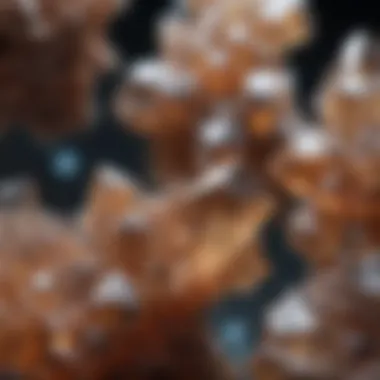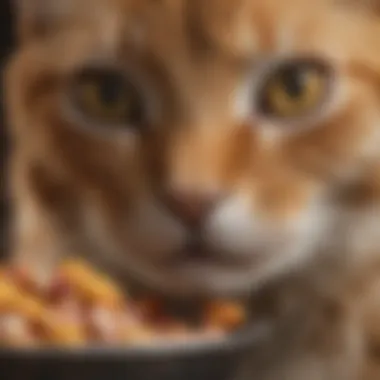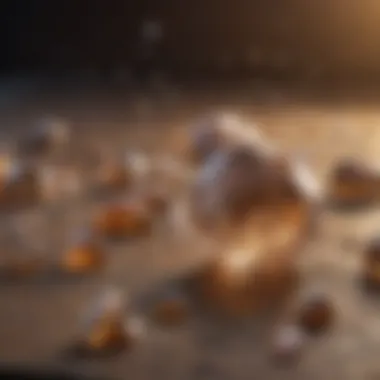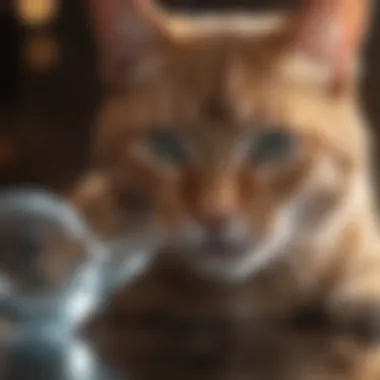Understanding Cat Urine Crystals and Dietary Solutions


Intro
Understanding the complexities of cat health involves recognising various conditions that can affect your feline companion. One such condition is the formation of urine crystals, which can lead to several health issues, including urinary tract infections and obstructions. These crystals do not only concern the physical discomfort of the cat but can also have long-term impacts on its overall health. Being informed about the causes and dietary solutions can help pet owners effectively manage this challenge.
This article delves into the formation of cat urine crystals, their underlying causes, associated symptoms, and the significant role of diet in managing this condition. We will examine specific dietary components and their effects on urinary health, equipping cat owners with the knowledge they need to make proactive decisions about their pet's diet. By understanding these factors, pet owners can play a crucial role in mitigating the risks associated with urine crystals.
Understanding Your Pet
Being aware of how different factors affect your cat's health is essential for optimal pet care. Every feline has a unique background, and understanding these differences can lead to better health management.
Breed Traits
Certain breeds, such as Persian and Siamese cats, may have a predisposition to urinary issues. The anatomical structure or genetic factors can contribute to this inclination. Recognizing these traits can aid in early detection and prevent serious complications.
Common Temperaments
A cat's temperament can influence their eating habits. Stressful environments may affect their food intake or may lead to changes in urination patterns. A calm atmosphere supports better health overall.
Special Needs
If your cat has already experienced urinary issues, they may have specific dietary needs that differ from a standard feeding regimen. Consulting with a veterinarian becomes critical to identify these needs accurately. Supplements or specialized diets could be required to aid in preventing further complications.
Pet Care Essentials
Proper care goes beyond a few daily meals. It includes understanding nutrition, grooming, and overall health strategies that play into the prevention of urinary crystals.
Nutrition and Feeding Guidelines
The diet is a vital aspect of managing cat health. A high moisture content in food helps dilute the urine, which can minimize the concentration of substances that contribute to crystal formation. Foods like Hill’s Prescription Diet c/d or Royal Canin Urinary SO are examples of specially formulated diets designed to keep urinary health in check.
Key Dietary Components
- Increased water intake
- Low magnesium and phosphorus levels
- Acidifying agents to lower urine pH
Grooming Tips and Techniques
Regular grooming not only prevents matting but can also enhance a cat's overall comfort and reduce stress, which might otherwise impact their urinary habits. Check for any signs of discomfort or difficulty when your cat uses the litter box.
Health and Wellness
Routine veterinary check-ups are necessary for maintaining long-term health. During these visits, discuss any changes in behavior or urination patterns. This awareness ensures that any potential issues can be recognized early.
Training and Behavior
Understanding cat behavior is crucial for providing a suitable environment that encourages good habits and health.
Basic Training Techniques
Positive reinforcement can be an effective way to train your cat to use the litter box. Ensure the litter box is kept clean and placed in a quiet, accessible location.
Behavioral Problems and Solutions
Aggression or avoidance can indicate discomfort. If a cat shows reluctance to use its litter box, it may be important to investigate potential health issues, including urinary problems.
Mental Stimulation Activities
Engaging your cat with toys can also provide mental stimulation, reducing stress levels, which may impact urinary health. Simple activities like interactive play can boost mood and health.
Engaging with Your Pet
Creating a strong bond with your cat is essential not only for enjoyment but for their overall wellbeing.
Interactive Games and Toys
Investing in various toys that stimulate your cat’s natural hunting instincts can encourage physical activity. This practice can help reduce the risks associated with obesity and urinary conditions.


Safe Outdoor Activities
If possible, leash training may allow safe outdoor exploration, offering sensory stimulation that can benefit their mental health.
Family-Friendly Pet Interactions
Encouraging family members to engage with the cat in gentle ways fosters socialization while promoting a sense of security in your pet.
Pet Adoption and Integration
If you are considering adopting a new pet, it is crucial to ensure compatibility with your lifestyle to promote a healthy environment.
Choosing the Right Pet for Your Lifestyle
Research different breeds and their characteristics. This understanding may inform your choices, considering factors like activity levels and health predisposition.
Preparing Your Home for a New Pet
Ensure that your space is prepared for a new cat by making essential arrangements, including litter box placement and feeding zones that promote comfort.
Tips for Smooth Prelims
Keep the initial introduction slow and controlled. Allow the new pet to explore at their own pace while ensuring existing pets are comfortable and secure. This method helps prevent stress and potential behavioral issues.
The information shared can empower pet owners to take their cat's health seriously. Understanding urine crystals and how to manage them will lead to improved well-being for your feline friend.
Overview of Cat Urine Crystals
Cat urine crystals present a significant concern for the health of felines. Understanding this issue is vital as it can lead to serious medical conditions if not addressed appropriately. Urine crystals can form when certain substances in the urine become concentrated and solidify. This process can occur for several reasons, including dietary and genetic factors.
A clear definition and awareness of the types of crystals present can aid in recognizing symptoms early. This knowledge not only benefits pet owners but also ensures the well-being of their pets by preventing complications associated with untreated crystals.
Definition and Types of Urine Crystals
Urine crystals are solid structures that form in the urine, usually consisting of minerals and waste. Common types of crystals found in cats include:
- Struvite Crystals: Typically associated with urinary infections and occur in alkaline urine.
- Calcium Oxalate Crystals: Can form in acidic or neutral urine and are linked to a higher dietary intake of certain minerals.
- Urate Crystals: These are rarer and can develop as a result of specific metabolic disorders or certain diets.
Each type has different causes and implications for treatment. Understanding these distinctions is crucial for proper dietary management and health monitoring.
Prevalence of Urine Crystals in Cats
Urine crystals are not uncommon in cats. Research indicates that approximately 10-20% of cats may develop urinary crystals at some point in their lives. This prevalence can be linked to various factors such as breed, age, and sex. For instance, male cats are often more susceptible due to their narrower urethra, which can lead to blockages.
It's also notable that indoor cats are at a higher risk, likely due to their less active lifestyles and the types of food they are fed. Understanding the prevalence helps identify at-risk pets, allowing for proactive measures to be implemented.
"Awareness of urine crystal types and their prevalence can empower cat owners to take action before serious health issues arise."
Causes of Urine Crystal Formation
Understanding the causes of urine crystal formation in cats is critical for effective management and prevention of this condition. Knowing the underlying factors helps pet owners make informed choices about their cats’ diet and lifestyle. Several key elements contribute to the development of urine crystals, which can have significant implications for feline urinary health.
Genetic Factors
Genetics play a vital role in the predisposition of certain breeds to develop urine crystals. Some breeds, like Persians and Burmese, are more prone to urinary issues, including crystals. This genetic susceptibility often influences the way a cat metabolizes nutrients, leading to imbalances that can precipitate crystal formation. Therefore, understanding a cat's breed can be crucial in assessing its risk and tailoring dietary strategies accordingly.
Environmental Influences
Cats’ environments can greatly affect their urinary health. Factors such as stress, litter box cleanliness, and available water sources can influence crystal formation. Cats are generally sensitive to changes in their surroundings, and stress can lead to urinary problems. A dirty litter box or inadequate number of boxes might discourage cats from urinating, causing concentrated urine that can lead to crystal formation. Moreover, if a cat does not have access to clean drinking water, it may become dehydrated, increasing the concentration of minerals in the urine and promoting crystal development.
Dietary Contributions
Diet is another significant factor affecting urine crystal formation. High levels of certain minerals, particularly magnesium, phosphorus, and calcium, can contribute to crystal formation. A diet that does not maintain a proper balance of these minerals can put a cat at risk. Additionally, the pH level of a cat’s urine is critical; diets that promote alkaline urine may accelerate the formation of certain types of crystals, such as struvite crystals. Choosing the right cat food, whether commercial or homemade, is essential for managing and preventing urine crystals.
A balanced diet that promotes hydration is crucial for maintaining optimal urinary health in cats.


In summary, the causes of urine crystal formation are intertwined with genetic predispositions, environmental stressors, and dietary choices. By understanding these causes, cat owners can actively participate in their pet's health management, reducing the risk of complications associated with urine crystals.
Symptoms and Diagnosis of Urinary Crystals
Recognizing the symptoms of urine crystals in cats is crucial for early intervention and treatment. A timely diagnosis can prevent serious complications. By being aware of what signs to look for, cat owners can monitor their pets' health more effectively. Regular observations during daily interactions with your cat can lead to quicker reporting of any unusual behavior to a veterinarian.
Common Symptoms in Affected Cats
Cats suffering from urinary crystals typically exhibit a range of symptoms. Some of the most common signs include:
- Frequent urination: Your cat may attempt to urinate more often but produce little urine each time.
- Straining to urinate: This may manifest as an apparent difficulty during urination, often accompanied by vocalization or signs of discomfort.
- Blood in urine: Hematuria can occur, leading to visibly discolored urine.
- Licking of the genital area: Increased grooming may indicate discomfort.
- Loss of appetite: A drop in food intake can be another warning sign, as affected cats may feel unwell.
If you notice any of these symptoms, it is important to consult a veterinarian for further evaluation. Addressing problems early can stave off more serious health issues.
Diagnostic Methods for Detection
Veterinarians have several methods for diagnosing urinary crystals. Common diagnostic techniques include:
- Physical examination: A thorough physical check can reveal signs of distress or abdominal discomfort.
- Urinalysis: This is a critical step; a sample of the cat’s urine is analyzed to detect crystals and assess other parameters like pH level and specific gravity.
- Imaging studies: X-rays or ultrasound may be employed to visualize the urinary tract and identify any blockages or abnormalities.
It is essential for pet owners to understand these diagnostic methods so they can ask informed questions when visiting the vet. Timely diagnosis coupled with effective treatment contributes significantly to the overall health of the cat.
Proper recognition and diagnosis of urinary crystals is essential for maintaining your cat’s health and wellbeing. These steps can assure that problems do not escalate into more severe conditions.
By staying observant and informed about these symptoms and diagnostic methods, cat owners can actively participate in their feline's health management, leading to better outcomes.
Nutritional Strategies for Managing Urine Crystals
Effective nutritional strategies are vital in managing cat urine crystals. Proper dietary management can mitigate the formation of these crystals and promote better urinary health in felines. It is essential to understand how specific dietary components work together to maintain an ideal urinary environment.
Key Dietary Components
Moisture Content
Moisture content in a cat’s diet plays a crucial role in urinary health. Cats have a natural tendency to drink less water compared to other animals. Thus, incorporating moisture-rich foods helps dilute their urine, reducing the concentration of minerals that form crystals. Wet food, containing around 75-80% moisture, is excellent for this purpose.
A high moisture content can reduce the likelihood of urinary tract issues. However, some cats might exhibit preferences for dry food, which can make it challenging to ensure adequate hydration. Therefore, finding a balance between wet and dry food is necessary to optimize moisture intake.
Mineral Balance
The balance of minerals in a cat's diet shapes its urinary health significantly. Key minerals, such as magnesium, phosphorus, and calcium, can contribute to crystal formation if present in excess. A diet designed with proper mineral ratios can help prevent the development of stones and crystals.
A crucial characteristic for maintaining mineral balance is choosing high-quality ingredients with a specified mineral composition. Uncontrolled intake of these minerals can lead to urinary issues over time. It's recommended for owners to consult with their vet about suitable diets that control mineral intake without sacrificing nutrition and overall health.
pH Regulation
The pH level of a cat’s urine can influence the formation of crystals. Certain types of crystals, like struvite, thrive in alkaline urine, while others, like calcium oxalate, form in acidic conditions. By regulating pH through diet, pet owners can manage or prevent crystal formation effectively.
Commercial diets are specially formulated to achieve an optimal urine pH. These diets often include specific ingredients that naturally assist in managing urinary acidity. The downside is that dietary changes should be gradual and closely monitored to ensure the cat adjusts without adverse effects.
Commercial Diets Formulated for Urinary Health
Pet food manufacturers offer commercial diets that are specifically formulated to promote urinary health. These diets typically focus on moisture content, mineral balance, and pH regulation, often verified through clinical studies.
Products such as Royal Canin Urinary SO or Hill's Prescription Diet c/d are among the most recommended by veterinarians for addressing urinary issues. These diets provide balanced nutrition and help prevent future crystal formation. However, these should only be used under direct guidance of a veterinarian to ensure the best results for your cat's unique health needs.
Homemade Diet Options
Preparing a homemade diet can be beneficial for some cat owners and their pets. Lawfully balanced homemade meals can help control ingredients, thus aiding in moisture content, mineral balance, and pH regulation. Yet, creating a properly balanced diet requires knowledge, so consulting with a veterinarian or a pet nutritionist is vital.
Consider the following when preparing homemade diets for urinary health:
- Use high-quality proteins.
- Include wet food components to boost moisture intake.
- Monitor and adjust mineral levels actively.
Even though homemade meals offer control over ingredients, they must still meet nutritional standards to ensure overall health.
Hydration and Its Role in Urinary Health
Hydration is a fundamental aspect of maintaining a healthy urinary system in cats. It directly influences the concentration of urine and the formation of crystals. An appropriate water intake helps dilute the minerals and compounds in the urine that could otherwise lead to crystal formation. Inadequate hydration increases the risk of urinary issues. Therefore, cat owners must prioritize hydration to promote urinary health.
Importance of Adequate Water Intake
Cats naturally have a low thirst drive, which can lead to insufficient water consumption. This makes it vital to understand how water intake affects crystal formation and overall urinary health.
- Dilution of Urine: Adequate water intake results in more dilute urine. This dilution lowers the concentration of potential crystal-forming substances like struvite and calcium oxalate.
- Avoiding Dehydration: Chronic dehydration can cause the urine to become overly concentrated, which increases the risk of urinary blockages. Regular water intake helps prevent these conditions.
- Support Kidney Function: Well-hydrated cats are less likely to experience kidney strain. The kidneys filter waste products, and if hydration is low, they can become overwhelmed, leading to health complications.


Techniques to Encourage Hydration
Encouraging cats to drink more water can be challenging. However, employing certain strategies can significantly enhance their water intake.
- Water Bowls: Use shallow bowls in multiple locations. Cats often prefer smaller, easy-to-access containers.
- Water Fountains: Many cats are attracted to flowing water. Investing in a water fountain can entice them to drink more.
- Wet Food: Incorporating wet food into the diet increases moisture content in what cats consume. This can be particularly effective in preventing urinary issues.
- Flavoring Water: Adding a small amount of low-sodium broth can make water more appealing to picky drinkers.
- Routine Monitoring: Keep track of your cat's water intake and urine output. Regular checks can help spot potential issues early on. Remember, subtle changes can indicate underlying health concerns.
"Encouraging proper hydration in cats can prevent serious health issues and enhance their quality of life."
By focusing on these hydration techniques, cat owners can play a crucial role in supporting their pets' urinary health, ultimately mitigating the risk of crystal formation.
Monitoring Cat Health
Monitoring the health of your cat is crucial, especially when dealing with issues like urine crystals. This section highlights the importance of regular health assessments and at-home monitoring techniques to ensure your feline remains fit and free from complications associated with urinary crystals.
Regular Veterinary Check-ups
Routine check-ups with a veterinarian are invaluable for early detection and management of health problems in cats. Vets can perform comprehensive exams, which may include urinalysis and blood tests to screen for the formation of urine crystals. Early detection is key; when caught in time, potential health risks can often be mitigated or completely avoided.
Regular veterinary visits are recommended at least once a year for healthy cats and more often for those with a history of urinary issues. During these visits, veterinarians can offer tailored advice on your cat’s diet, hydration, and lifestyle. The benefits of regular veterinary check-ups include:
- Preventative Care: Early identification of health issues to prevent serious conditions later.
- Tailored Advice: Specific dietary recommendations based on your cat's condition.
- Professional Monitoring: Ongoing evaluation by trained professionals who can spot changes effectively.
At-home Monitoring Techniques
Paying attention to your cat’s behavior at home is critical. By regularly checking specific indicators, owners can identify potential urinary problems before they escalate. Key at-home monitoring techniques include:
- Observing Litter Box Habits: Monitor the frequency and consistency of urination. Changes may signal a urinary tract issue.
- Changes in Drinking Habits: Increased or decreased water intake can reflect an underlying health condition. Make sure your cat has constant access to fresh water.
- Behavioral Changes: Watch for any indications of discomfort or distress, such as frequent straining to urinate or crying out while using the litter box.
- Weight Monitoring: Regularly weigh your cat. Sudden weight loss or gain can indicate health issues that require veterinary attention.
Regular monitoring of your cat's health can serve as an early warning system, helping to avert severe complications from untreated urinary crystals.
By combining professional veterinary care with at-home monitoring, pet owners can create a comprehensive strategy for maintaining their cat's health. This approach not only provides peace of mind but also plays a significant role in preventing and managing issues related to urine crystals.
Potential Complications from Untreated Crystals
Understanding the potential complications from untreated urine crystals in cats is vital. Many cat owners might overlook this issue until it escalates into a serious health concern. By addressing it promptly, one can avoid severe consequences that could affect the cat's overall well-being.
Risk of Urinary Blockages
One of the most significant risks associated with untreated urine crystals is the possibility of urinary blockages. These blockages occur when crystals aggregate and form larger stones, which can obstruct the urinary tract. This complication most frequently affects male cats due to their narrower urethra. A blocked urinary tract is a critical situation that can lead to severe pain, inability to urinate, and eventually kidney damage or even death if not treated immediately.
Signs of a urinary blockage may include:
- Frequent trips to the litter box without producing urine
- Vocalization due to pain
- Excessive grooming of the genital area
- Lethargy
- Loss of appetite
If these symptoms are observed, it is important to seek veterinary care right away. Delaying treatment can be life-threatening.
Long-term Health Consequences
When urinary crystals are left untreated, the long-term consequences can be quite dire. Chronic irritation of the bladder lining may lead to recurring urinary tract infections, which can further complicate the health of the cat. This persistent inflammation can result in a condition called cystitis.
Moreover, the continuous presence of crystals may precipitate the formation of urinary stones, often referred to as uroliths. Once stones develop, surgery might become necessary, increasing the financial and emotional burdens on the pet owner. The stress of such medical interventions may also affect the cat's mental health and behavior.
Long-term impacts might include:
- Decreased quality of life
- Frequent vet visits and associated costs
- Increased anxiety or stress in cats from repeated medical issues
In essence, untreated urine crystals pose serious risks that extend beyond immediate health problems. Keeping an eye on dietary habits and ensuring adequate hydration can help mitigate these risks. Educating oneself about the signs and symptoms is crucial for effective management.
The End
The conclusion serves as a significant component in this exploration of cat urine crystals and their dietary management. It synthesizes the key points discussed throughout the article, emphasizing the critical relationship between diet and urinary health in felines. Understanding this is not just beneficial but essential for pet owners. It allows for better informed decisions regarding nutrition and can lead to improved outcomes for cats prone to urine crystal formation.
Summary of Dietary Importance
Dietary management is vital for mitigating the risks associated with cat urine crystals. A few important considerations regarding diet include:
- Moisture content: Cats naturally have a low thirst drive, which makes hydration through food crucial. Moist food can help prevent concentrated urine.
- Mineral balance: Certain minerals, such as magnesium, calcium, and phosphorus, directly influence crystal formation. Adjusting their levels can lead to healthier urinary conditions.
- pH regulation: The acidity or alkalinity of the urine affects crystal development. A balanced diet can help maintain appropriate pH levels.
Furthermore, commercial diets specifically formulated for urinary health can provide tailored solutions. These diets often contain controlled levels of minerals and enhanced moisture content.
Pet owners also have the option of preparing homemade meals that consider these factors. However, it’s essential to ensure these diets are nutritionally complete and balanced.
In summary, understanding the dietary importance is not just about food choices. It involves recognizing how nutrition plays a crucial role in a cat’s overall health, particularly regarding urinary problems. Adjustments in diet can significantly impact a cat's wellbeing and prevent serious health issues linked to urine crystals. Therefore, pet owners are encouraged to evaluate and manage their cat’s diet diligently.



